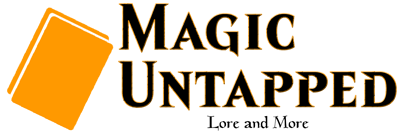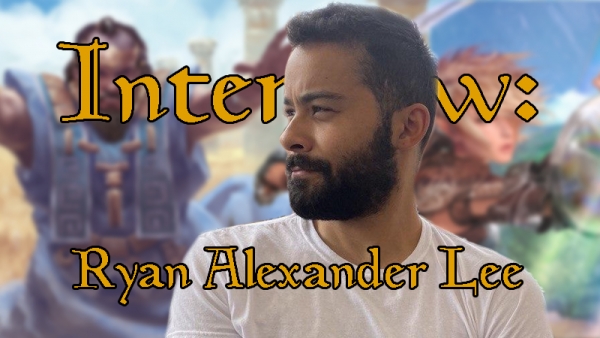Magic: The Gathering artist Ryan Alexander Lee joins Magic Untapped for a Q&A.
For almost a decade, Ryan Alexander Lee has been creating art for Magic: the Gathering and, seemingly, for every company in between such as 21st Century Fox and Namco. For Wizards of the Coast, he has even worked on more select projects such as concept art for world building purposes.
Lee took a moment to answer some questions from Magic Untapped about Magic: The Gathering, his career, recent changes in Magic, and what he's up to currently.
Magic Untapped: What inspirations and influences in your life drove you to becoming a professional artist?
Ryan Alexander Lee: I actually have a very specific answer for this! I think I was about three or four years old when I first saw Mothra Vs. Godzilla and being so awestruck by the movie, I pretty much never stopped drawing after that. I drew all kinds of animals, monsters, and weird creatures almost exclusively until I was a little older and became obsessed with Indiana Jones and pulp adventure stories. Then of course, JRPGs like Final Fantasy and Chrono Trigger followed after that. There was a funny meme I saw on Twitter a while back about artists who grow up liking anime and being influenced by it, then get shamed out of it in art school only to return to drawing it in their late 20s/early 30s. I definitely resonate with that one, haha.
MU: How did you get into doing artwork for Magic: The Gathering? Did you reach out to Wizards of the Coast or did they reach out to you?
RAL: I think it was back in 2012 or ‘13 when I submitted a couple of illustrations for a fantasy art challenge online. I expressed interest in working on Magic cards and, shortly after managing to win the contest, I was contacted by Jeremy Jarvis.
MU: How long do you typically spend on a piece?
RAL: I’ve gotten a lot faster since I started--and surprise, it comes with daily, consistent practice. Starting out, there were many stresses and it was actually pretty difficult to come up with a finished illustration in less than a couple of weeks. Now, with experience things tend to move more quickly--sometimes two to four days, not counting gathering reference and the initial planning, of course. I’d also add that artists definitely have to keep pushing for better rates and options too, because financial incentives do tend to motivate and encourage better work. Who knew that when you don’t have to worry about making rent that you can actually produce significantly better work? It baffles me that companies don’t realize the net improvement this would bring to their products and overall success.
MU: We noticed that you, along with Magic artist Daarken (whom we interviewed previously) and a few others, did a number of concept art pieces for the Amonkhet block a few years back. What was that experience like?
RAL: That was fun! That was actually my second in-house concept art push; the first being the return to Zendikar. They are usually three week stints in Renton, Wash., where you basically just grind out as much concept art as you can within that time. Everyone on the team would often stay after hours and work pretty late into the night. I think my favorite part was watching the review wall grow as we’d continue to print out and pin up our concepts for the team to check out. It would get to the point where you had to walk across the room just to see it all.
MU: You’ve done the artwork on many Magic cards so far. Which of your cards have been your favorites and what is it about them that makes them stand out?
RAL: I think my favorite cards are the ones that I know will be well received by fans of the game. Any of the cards that prove particularly useful in people’s decks have always felt really good to work on.
For example, a good friend posed as a reference for the Snapcaster Mage card. Neither of us realized it at that time, but it really blew up when it came out. People really responded to the release of that card, and I’ve even received some ‘fist-shaking’ angry letters from those who’ve lost important matches due to that card. Now my friend, Dave, has to dodge people recognizing him as the character and deals with having people he works with stick printouts of the card on his office door. His life is ruined.
MU: Have you ever tried a more "out of the box" approach to a card where you try a new perspective or style?
RAL: Not really, but I’d certainly like to try something new. It seems like WotC is becoming more amenable to different approaches than the standard "highly-rendered" look in recent times (not that I don’t love that too, I do). That’s something I really feel like I missed out on from the early days of MTG. I’ve seen some new cards come out recently that look like they’re from a '90s Marvel comic, which is great--I’d love to see a set with wildly different styles than what people have come to expect of Magic!
MU: As we were doing our research for this interview, we noticed that among the more than 400 artists who have contributed toward the game of Magic: The Gathering that very few are black. Is this consistent with your experience as a black fantasy artist and what do you feel needs to change to allow more people of color (and, quite frankly, minorities in general) more opportunity to showcase their artistic talents in the game of Magic?
RAL: I have noticed, and like many other black artists I’ve tried as hard as possible to not pay attention to it and just work around it or through it--but you can’t always do that; it has a way of coming up again and again. I think that’s why a lot of black artists have recently expressed fatigue, though the sudden influx of attention is a wonderful thing overall.
It seems to me like a "sea change" has already begun and we’ll likely be seeing a lot more representation in pop culture and other sources of entertainment, which is all to the good. When I was younger I was always advocating for more diverse protagonists in the stories we read and watch because I’ve always believed that these were tools of empowerment to young minds. It’s easier to feel like the hero of your own movie and craft inspiring mental models when you’ve digested countless stories of other heroes that look like you when growing up.
MU: What kinds of things are more tricky for you to create (landscapes, people creatures, etc.)?
RAL: Buildings and structures, 100% mostly because I still struggle to find the same joy in drawing them as I get from people, creatures, and even landscapes. I can paint rocks, foliage, and rivers all day--but designing actual buildings and rigid structures, UGH. I’ve resorted to mocking up basic geometry in Maya or 3DCoat and photobashing in many cases just to get my footing to prep for finished illustrations. In any case, it’s something I’m aware of and actively working at improving.
MU: Very recently, Wizards of the Coast banned several cards that the company considered to be racially insensitive or just flat-out racist due to the card's artwork, text, or otherwise. What're your thoughts on the decision and do you feel more needs to be done?
RAL: Aw man, this one’s tricky for me. I have traditionally been vehemently against censorship of any kind. I believed that banning, blocking, sweeping over, or destroying history is more likely to get us right back to where we started rather than onto something better and new. Human beings are so bad at long-term thinking and we always think we’re acting with the best intentions. Sadly, history is littered with examples of this, that only really give context and clarity in hindsight. HOWEVER, I also understand the need to remove symbols that harm or represent real hatred towards others--these things never deserved a place under the sun and should absolutely be removed from public spaces. Overtly racist cards have no place in a family-friendly game--so good move, WotC.
MU: What projects are you working on now (Magic: The Gathering or otherwise)?
RAL: I am currently working on a couple of new cards for MTG that I will obviously share as soon as I am able.
I also have a personal comic called HESSYST that I plan to start releasing in the coming weeks. The story begins with a proud warrior-people called Paelads, who have their entire world upended by a malevolent entity simply known as "Hessyst."
It is a cosmic-horror story set in a fantasy universe that walks a fine line between whimsy and terror. My story inspiration has been drawn from Final Fantasy VII, The Dark Tower’series, and The Fountain, to name a few. Stylistically, I’ve taken inspiration from Miyazaki, [The Legend of] Zelda, Avatar: The Last Airbender, and Vampire Hunter D: Bloodlust.
You could say that this project is a culmination of my work from some of the many inspirations that got me drawing in the first place.
For more info on that, stay tuned to my Twitter, Instagram, and/or Tumblr accounts @ryanleeart
Thank you to Ryan for participating in this interview.









